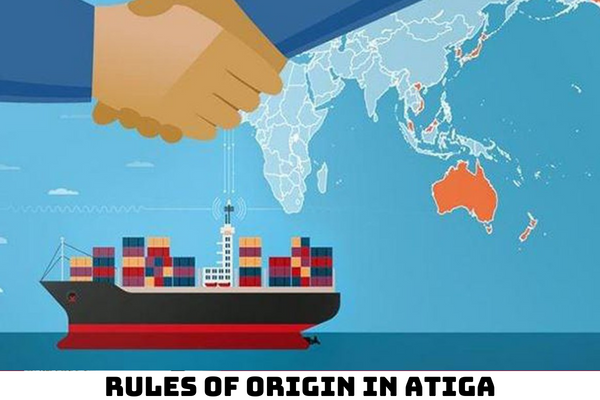Vietnam: What are the regulations on origin declaration under the Rules of Origin in the ASEAN Trade in Goods Agreement (ATIGA)?
- What are the regulations on origin declaration in Vietnam under the Rules of Origin in the ASEAN Trade in Goods Agreement (ATIGA)?
- When will origin declarations under the Rules of Origin in the ASEAN Trade in Goods Agreement be submitted in Vietnam?
- When will origin declarations under the Rules of Origin in the ASEAN Trade in Goods Agreement be not required in Vietnam?
What are the regulations on origin declaration in Vietnam under the Rules of Origin in the ASEAN Trade in Goods Agreement (ATIGA)?
Pursuant to Article 12 of Appendix I promulgated together with Circular 10/2022/TT-BCT stipulating as follows:
- When exporting originating goods, a certified exporter shall be allowed to make out an origin declaration on the commercial invoice.
- If the origin declaration cannot be made out on the commercial invoice at the time of exportation, the certified exporter may make out it on any of the following documents:
+ Billing statement.
+ Delivery order.
+ Packing list.
The document containing the origin declaration will be accepted at the time of importation if submitted together with the commercial invoice.
- The origin declaration shall contain all of required information as follows:
+ Details on the certified exporter, including the authorisation code.
+ Description of the goods in sufficient details to enable them to be identified for origin determination purposes, including:
(i) Name of the product.
(ii) HS in 6 digit or AHTN code.
(iii) Origin conferring criterion.
(iv) Country of origin.
(v) FOB price when the regional value content origin criterion is used.
(vi) Quantity of goods.
(vii) Trademark, if applicable.
(viii) For the case of back-to-back origin declaration, original proof of origin reference number, date of issuance, country of origin of the first exporting country, and, if applicable, the authorisation code of the first exporting country.
+ Certification by an authorized signatory of the certified exporter, including:
(i) Certification that the goods specified in the origin declaration meet all the relevant requirements of Chapter 3 of the ATIGA Agreement;
(ii) Authorized signature over the name of the signatory.
- The origin declaration shall be made in the English language and bear a manually executed signature and printed or stamped name of the authorized signatory.
- The reference number and the date of the document containing the origin declaration shall be considered as the reference number and the issuance date of the origin declaration.
- If in case the space provided for in the origin declaration is not sufficient to list out all the products, additional page(s) could be attached. An additional page shall contain sufficient information as set out in Clause 3 of this Article.
- The provisions in Clause 2 through 6 of this Article shall not apply to the pilot implementation of self-certification of origin as set out in the Memorandum of Understanding signed on August 29, 2012 among Lao People's Democratic Republic, the Republic of the Philippines, the Republic of Indonesia in Siem Reap, the Kingdom of Cambodia, on the second pilot project for the implementation of a regional self-certification system (hereinafter referred to as “pilot scheme”).

When will origin declarations under the Rules of Origin in the ASEAN Trade in Goods Agreement be submitted in Vietnam?
Pursuant to Article 14 of Appendix I promulgated together with Circular 10/2022/TT-BCT stipulating as follows:
Submission of origin declarations
1. For the purposes of claiming preferential tariff treatment, the importer shall submit a C/O Form D or an origin declaration, including supporting documents, to the customs authority of the importing Member State at the time of import.
Accordingly, the importer shall submit a C/O Form D or an origin declaration, including supporting documents, to the customs authority of the importing Member State at the time of import for the purposes of claiming preferential tariff treatment.
In addition, in cases when an origin declaration is rejected by the customs authority of the importing Member State, the subject origin declaration shall be returned to the competent authority of the exporting Member State within a reasonable period not exceeding 60 days.
The importing Member State should duly notify the competent authority of the exporting Member State of the grounds for the denial of tariff preference.
At this time, the importing Member State should accept and consider the clarifications made by the C/O issuing authority or competent authority of the exporting Member State and assess again whether or not the proof of origin can be accepted for the granting of the preferential treatment.
The clarifications made by the C/O issuing authority or competent authority of the exporting Member State should be detailed and exhaustive in addressing the grounds of denial of preference raised by the importing Member State.
When will origin declarations under the Rules of Origin in the ASEAN Trade in Goods Agreement be not required in Vietnam?
Pursuant to Article 16 of Appendix I promulgated together with Circular 10/2022/TT-BCT on waiver of proof of origin as follows:
In the case of consignments of goods originating in the exporting Member State and not exceeding US$ 200 (two hundred) FOB, the production of a proof of origin shall be waived and the use of simplified declaration by the exporter that the goods in question have originated in the exporting Member State will be accepted. Goods sent through the post not exceeding US$ 200 (two hundred) FOB shall also be similarly treated.
Thus, goods originating from exporting Member States with a FOB value of not more than 200 USD are exempt from submitting origin declarations under the Rules of Origin in the ASEAN Trade in Goods Agreement.
LawNet
